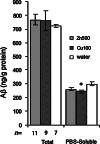Chronic exposure to high levels of zinc or copper has little effect on brain metal homeostasis or Abeta accumulation in transgenic APP-C100 mice
- PMID: 19381799
- PMCID: PMC11505849
- DOI: 10.1007/s10571-009-9401-7
Chronic exposure to high levels of zinc or copper has little effect on brain metal homeostasis or Abeta accumulation in transgenic APP-C100 mice
Abstract
Aberrant metal homeostasis may enhance the formation of reactive oxygen species and Abeta oligomerization and may therefore be a contributing factor in Alzheimer's disease. This study investigated the effect of chronic high intake of dietary Zn or Cu on brain metal levels and the accumulation and solubility of Abeta in vivo, using a transgenic mouse model that over expresses the C-terminal containing Abeta fragment of human amyloid precursor protein but does not develop amyloid deposits. Exposure to chronic high Zn or Cu in the drinking water resulted in only slight elevations of the respective metals in the brain. Total Abeta levels were unchanged although soluble Abeta levels were slightly decreased, without visible plaque formation, enhanced gliosis, antioxidant upregulation or neuronal loss. This study indicates that brain metal levels are only marginally altered by long term oral exposure to extremely high Cu or Zn levels, and that this does not induce Abeta-amyloid formation in human Abeta expressing, amyloid-free mice, although this is sufficient to modulate Abeta solubility in vivo.
Figures

 and controls ■ were determined by ANOVA with genotype as an independent variable, and values are indicated above each box. Post-hoc Scheffé tests were used to test for significant differences in TgC100 and NTg mouse lines individually (*P < 0.05). Boxes represent average ±SEM, and whiskers represent 1.96*SEM
and controls ■ were determined by ANOVA with genotype as an independent variable, and values are indicated above each box. Post-hoc Scheffé tests were used to test for significant differences in TgC100 and NTg mouse lines individually (*P < 0.05). Boxes represent average ±SEM, and whiskers represent 1.96*SEM


Similar articles
-
Overexpression of Abeta is associated with acceleration of onset of motor impairment and superoxide dismutase 1 aggregation in an amyotrophic lateral sclerosis mouse model.Aging Cell. 2006 Apr;5(2):153-65. doi: 10.1111/j.1474-9726.2006.00200.x. Aging Cell. 2006. PMID: 16626394
-
Metals and amyloid-beta in Alzheimer's disease.Int J Exp Pathol. 2005 Jun;86(3):147-59. doi: 10.1111/j.0959-9673.2005.00434.x. Int J Exp Pathol. 2005. PMID: 15910549 Free PMC article. Review.
-
Low levels of copper disrupt brain amyloid-β homeostasis by altering its production and clearance.Proc Natl Acad Sci U S A. 2013 Sep 3;110(36):14771-6. doi: 10.1073/pnas.1302212110. Epub 2013 Aug 19. Proc Natl Acad Sci U S A. 2013. PMID: 23959870 Free PMC article.
-
Dietary Cu stabilizes brain superoxide dismutase 1 activity and reduces amyloid Abeta production in APP23 transgenic mice.Proc Natl Acad Sci U S A. 2003 Nov 25;100(24):14187-92. doi: 10.1073/pnas.2332818100. Epub 2003 Nov 14. Proc Natl Acad Sci U S A. 2003. PMID: 14617773 Free PMC article.
-
Alzheimer's disease, beta-amyloid protein and zinc.J Nutr. 2000 May;130(5S Suppl):1488S-92S. doi: 10.1093/jn/130.5.1488S. J Nutr. 2000. PMID: 10801964 Review.
Cited by
-
Neuroprotective effects of some seaweeds against Zn - induced neuronal damage in HT-22 cells via modulation of redox imbalance, inhibition of apoptosis and acetylcholinesterase activity.Metab Brain Dis. 2019 Dec;34(6):1615-1627. doi: 10.1007/s11011-019-00469-2. Epub 2019 Jul 26. Metab Brain Dis. 2019. PMID: 31346859
-
High dose zinc supplementation induces hippocampal zinc deficiency and memory impairment with inhibition of BDNF signaling.PLoS One. 2013;8(1):e55384. doi: 10.1371/journal.pone.0055384. Epub 2013 Jan 31. PLoS One. 2013. PMID: 23383172 Free PMC article.
-
Zinc and its effects on oxidative stress in Alzheimer's disease.Neurol Sci. 2014 Jun;35(6):923-8. doi: 10.1007/s10072-014-1668-x. Epub 2014 Feb 13. Neurol Sci. 2014. PMID: 24522515 Review.
-
Dietary zinc supplementation of 3xTg-AD mice increases BDNF levels and prevents cognitive deficits as well as mitochondrial dysfunction.Cell Death Dis. 2010 Oct 28;1(10):e91. doi: 10.1038/cddis.2010.73. Cell Death Dis. 2010. PMID: 21368864 Free PMC article.
-
Zinc overload enhances APP cleavage and Aβ deposition in the Alzheimer mouse brain.PLoS One. 2010 Dec 17;5(12):e15349. doi: 10.1371/journal.pone.0015349. PLoS One. 2010. PMID: 21179415 Free PMC article.
References
-
- Adlard PA, Cherny RA, Finkelstein DI, Gautier E, Robb E, Cortes M, Volitakis I, Liu X, Smith JP, Perez K, Laughton K, Li QX, Charman SA, Nicolazzo JA, Wilkins S, Deleva K, Lynch T, Kok G, Ritchie CW, Tanzi RE, Cappai R, Masters CL, Barnham KJ, Bush AI (2008) Rapid restoration of cognition in Alzheimer’s transgenic mice with 8-hydroxy quinoline analogs is associated with decreased interstitial Abeta. Neuron 59:43–55 - PubMed
-
- Armendariz AD, Gonzalez M, Loguinov AV, Vulpe CD (2004) Gene expression profiling in chronic copper overload reveals upregulation of Prnp and App. Physiol Genomics 20:45–54 - PubMed
-
- Atwood CS, Moir RD, Huang X, Scarpa RC, Bacarra NM, Romano DM, Hartshorn MA, Tanzi RE, Bush AI (1998) Dramatic aggregation of Alzheimer abeta by Cu(II) is induced by conditions representing physiological acidosis. J Biol Chem 273:12817–12826 - PubMed
-
- Atwood CS, Huang X, Moir RD, Tanzi RE, Bush AI (1999) Role of free radicals and metal ions in the pathogenesis of Alzheimer’s disease. Met Ions Biol Syst 36:309–364 - PubMed
Publication types
MeSH terms
Substances
LinkOut - more resources
Full Text Sources

